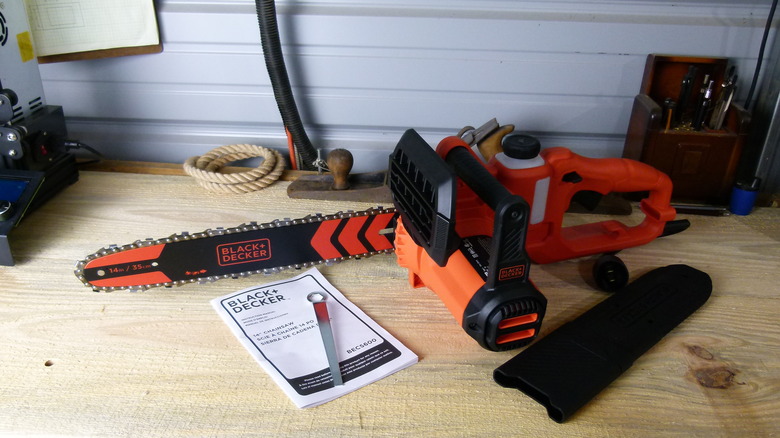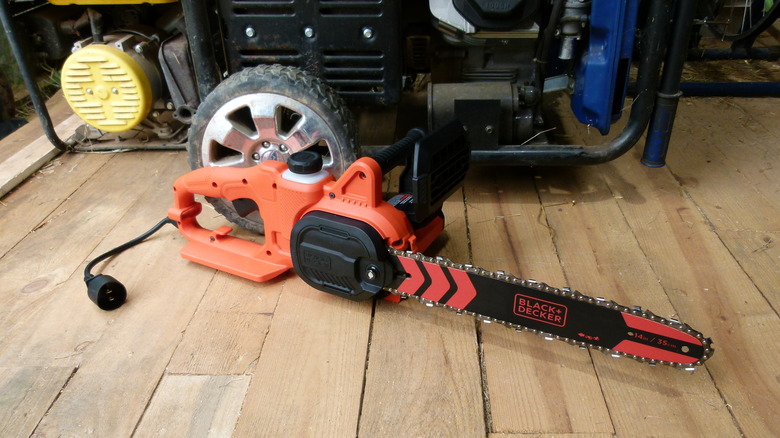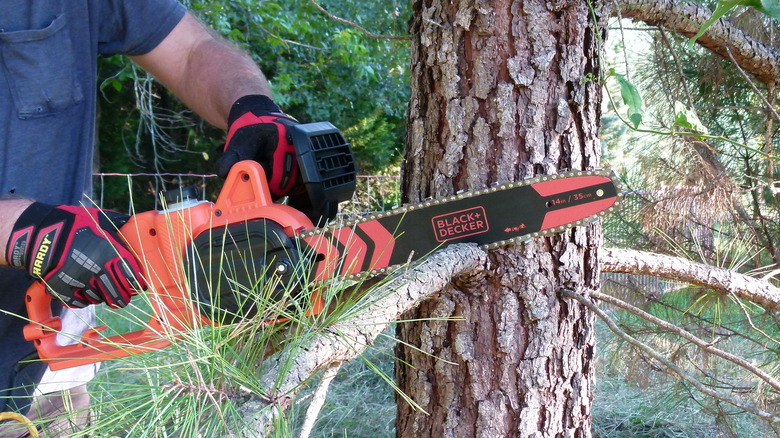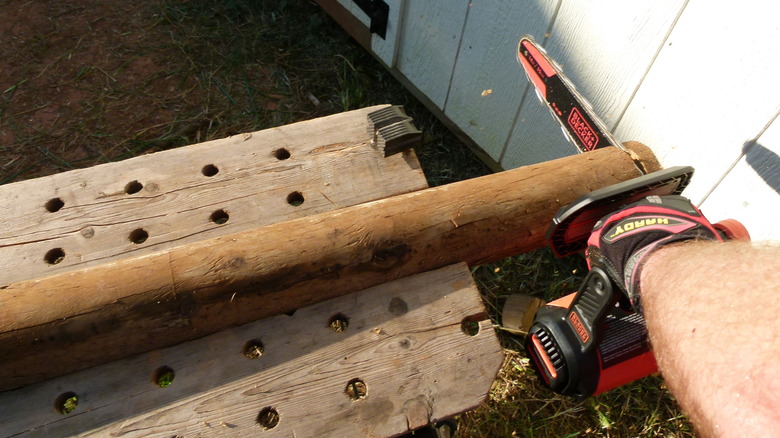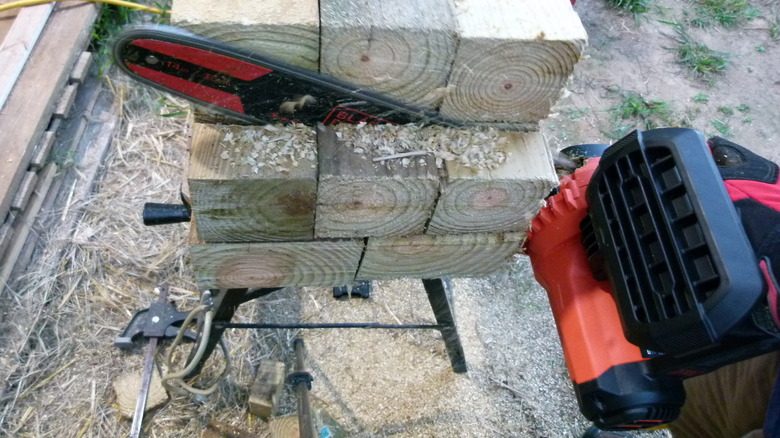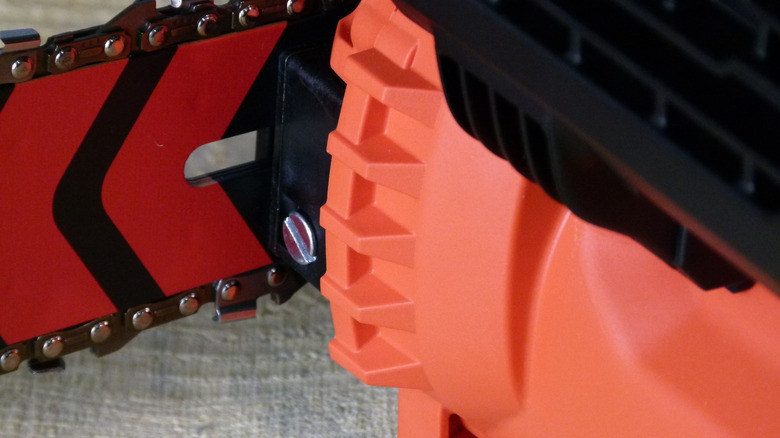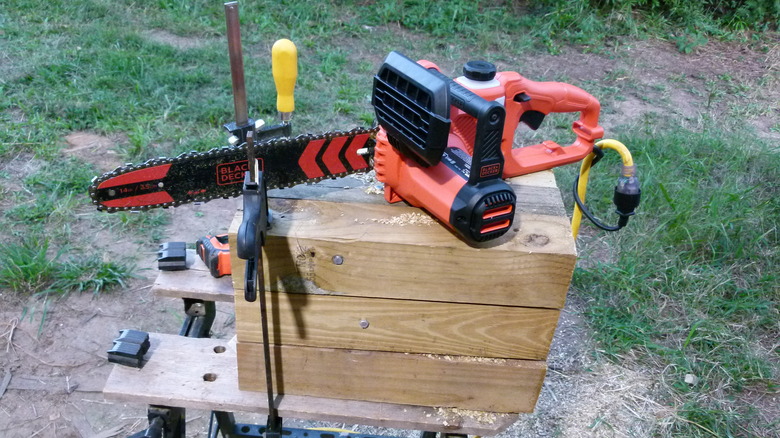We Tried The Cheapest Mini Chainsaw At Home Depot. Here's How It Went
To find the Black & Decker 14-inch corded chainsaw at our local Home Depot, you must walk all the way down to the end of the aisle, peer behind a post, and look in the highest corner. There you might find two of them, along with a desiccated mouse and someone's long-lost cellphone. It might be similar to the experience of seeking out the vaguely disreputable products that used to be kept in stores' back rooms, perhaps behind a curtain to minimize shame and gawking. This wasn't helped by the employee who helped us find it with a sympathetic smile, encouraging tone, and gentle lie about owning this saw himself.
After checking that it hadn't been returned, we carried it around the store for a while to gather other supplies, then headed for checkout. According to a reviewer, the $89 saw cost $59 in August 2021, before inflation (and whatever other economic forces affect chainsaws) took hold. The light 9.4-lb. saw and its packaging feels more like $59 when you're ambling back and forth endlessly in the fastener aisle with the saw in tow.
Home Depot only stocked a handful of chainsaws, and only three corded models: this 14-inch, 8 amp Black & Decker BECS600; the $129, 14-inch, 9-amp Homelite UT43104, and the $149, 16-inch, 12-amp Homelite UT43123. The only smaller saws are pole saws, pruning saws, and battery-operated chainsaws. At 14 inches, you begin to see gas-powered models ... down at the respectable end of the aisle.
The Black & Decker BECS600 at a glance
All evidence suggests that the Black & Decker BECS600 was conceived as a low-spec tool. Its 8-amp motor is the smallest at Home Depot, and even the specs that stand out as better-than-average turn out to be somewhat worse-than-average. The "brushless motor for maximum power and durability" mentioned on the product's Home Depot page would be impressive on such an inexpensive device, but the manufacturer's replacement parts list clearly shows motor brushes.
The saw's motor speed isn't published anywhere by Black & Decker, but it can be deduced from the 8 m/s chain speed and the number of teeth on the drive sprocket (five), so we calculated 5039 RPM ... underwhelming in an era of 10,000 to 14,000 RPM gas-powered saws. And most chainsaws have sharp metal "bucking spikes" (also called "bumper spikes") designed to bite into the wood so the saw can be safely pivoted with leverage, but this one has some raised plastic ridges that will surely provide more friction than bite.
Then there's the issue of the bar size. Home Depot's in-stock chainsaws with bars longer than 12 inches will typically cut a log about 170% to 180% of the bar length. So, a 14-inch saw is usually rated for a 24-inch log, the maximum cut diameter of the only other 14-inch saw in stock. Yet the BECS600 is only rated for 12 inches. The only saws with a smaller max cut diameter are small battery-operated chainsaws and pruning saws.
How we tested the BECS600
Chainsaw testing is mostly about cutting things, so we picked a few things to, well, cut. We pruned lower limbs from a pine tree, shortened 4-inch fence posts, and gleefully removed a Bradford pear — an invasive species that's beautiful for 27 minutes each year (if you can bear its scent) and that spends its entire lifecycle choking out native species and trying its best to fall on you, your family, or your possessions. (The only reason people don't take them down for fun is that they cut themselves down sooner or later, though not soon enough.)
Without a Bradford pear or anything equally undesirable 12 inches long, we devised and lag-screwed a similar-sized arrangement of 4x4 and 4x6 pressure-treated pine lumber that would simulate a 12-inch tree branch by having about the same surface area and, if cut at the right angle, about 12 inches in thickness.
Particularly while working on smaller pieces, we carefully tested the boundaries of a few safe-use rules such as cutting with the tip of the saw and allowing the blade to be pinched slightly by over-under bucking (that is, under bucking too much), to see how the saw responded. (Bucking is simply cutting a felled tree, and under bucking is cutting it in an upwards stroke from below.) For the more demanding portions of the testing, we used a 10-gauge extension cord rated for 20 amps to avoid voltage drop, reduced amperage, and motor overheating, per Consumer Reports.
What we liked about the Black & Decker BECS600
It gets a little dicey, examining a bad idea and trying to figure out when it works out okay. You're always at risk of waving off the bad stuff in favor of a minor positive (lawn darts are risky, sure, but it's important that children play outside). Or you can go the other way and determine that the negative minutia overpowers the upside (Roger quit playing tennis because he found the racket styling too derivative of flashy motorsports graphics).
The BECS600 cut through 5-inch branches with little trouble. In fact, the saw handled the little stuff so well that at one point we expected to be writing a glowing review. It is light, easy to handle, and showed no sign of kicking off the chain constantly, as was reported by many reviewers (and experienced by nearly everyone who's owned an inexpensive chainsaw). It didn't seem prone to kickback, and only skittered across the wood's surface alarmingly once when the saw was lowered before reaching full speed, in defiance of the user manual. And the manual is decent, by the way ... even though one reviewer said, with hilarious understatement, "After reading the manual I had my neighbor give me instructions."
Other reviews expressed frustrations we couldn't unpuzzle. One said she had "trouble cutting even a shrub," a claim that doesn't seem credible. But 82% of Home Depot reviewers recommend the BECS600, which is an impressive number for the cheapest version of anything.
How the chainsaw could be improved
One reviewer observed that "If you have the means to sharpen your own chain blades, this is a great buy" — presumably meaning that this saw's blade dulls rather quickly but other than that it's pretty good. Alas, that's going too far in the other direction because, while we had no trouble cutting anything close to shrub-sized, the 10.5 x 10.5ish manufactured tree trunk test was pretty close to a disaster. On three cuts, it took an average of 1:12 to saw through the entire thing. For context, the Project Farm YouTube channel performed a similar test with various gas- and battery-powered saws cutting through nine 4x4s (cross-section area of 110.25 square inches) and the worst time across all 13 saws tested was 21.7 seconds ... about 30% as long as our test with 112 square inches of wood. (For reference, an actual 12-inch log would be a little over 113 square inches.)
This doesn't quite pass the sniff test for Black & Decker making good on their claims. Sure, it cut through the wood, but you could eventually cut through it with a steak knife, too. And it gets worse: The 1:12 was with a significant amount of human effort pushing, pulling, repositioning, and cursing at the saw. Bucking and limbing an entire 12-inch tree would be exhausting, maybe impossible.
Piling on: Adding up the minutia
There are probably some safety improvements that can be made to the BECS600 as well. It does feature an anti-kickback chain but a no manual or inertial chain brake to make an out-of-control saw safer. The anti-kickback chain is important for novice users, says chainsaw manufacturer Oregon Tool. And Chainsaw Larry (probably not "The Walking Dead" character) picked three brake-less saws as his top corded chainsaws, so it's not unheard-of. But some key features are missing, like a tip guard to further reduce kickback. It does come with a scabbard, which was sometimes so difficult to remove that we intentionally lost it pretty early in day two of testing.
There were a few minor annoyances as well. As several reviewers noted, this saw (which has a fixed-rate automatic oiler) uses a tremendous amount of bar and chain oil. And by "uses" we mean "spits out all over the saw, the wood, the environment, the camera, the dog, and incautious low-flying birds."
The cord loop retention mechanism was too small to accept our 10-gauge extension cord, although to be fair, you probably don't need a cord that thick for an 8-amp saw. Black & Decker says the max cord length is 150 feet, so voltage drop clearly isn't much of an issue, and that you can use an 18-gauge extension cord if it's 25 feet long or shorter ... very small for a corded chainsaw.
Would we buy it again? Well, no, but ...
A final verdict on this chainsaw seems pretty cut-and-dry. Or maybe just cut, which would take forever and leave no time for drying. But there are other ways to look at some of this; let's start with safety. The absence of a tip guard seems objectively bad, but professional chainsaw users disagree. This feature is usually viewed by pros with skepticism or outright derision because it limits the way a chainsaw can be used. You might not be concerned about these limitations as a beginner, but it would definitely limit your growth and capabilities as a chainsaw user.
The small cutting capacity (half the 24 inches you usually see for a 14-inch chainsaw) might seem terrible, but Chainsaw Larry reckons that a chainsaw blade should be 2 or more inches longer than the wood you plan to cut ... right where the BECS600 is. This would be easier to swallow if the saw could cut a 12-inch log in a reasonable amount of time.
But here's the thing: Take a tape measure around your neighborhood and roughly measure the diameter of some trees. Unless you live in a primordial forest, you're probably going to find relatively few 12-inch trees that anyone would want to take down. The task is just not that common from the exurbs in. Pruning, on the other hand, is something most of us could stand to do more of, and this would make a decent pruning saw.
